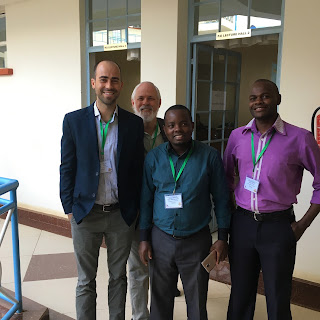Last night we arrived home from Nairobi after attending the
2016 Primafamed meeting on Family Medicine’s contribution to Sustainable Development Goal 3, also known as the main health goal (one of 17 SDGs). This
brought together Family Medicine leaders and advocates from around the continent
to share ideas on the current state of and future plans for the growth of
Family Medicine throughout sub-Saharan Africa (SSA). Boaz, one of our
residents, and I enjoyed meeting a lot of the academic “celebrities” of Family
Medicine this weekend. When you are widely published in a field, your nametag
will get frequent glances!
Reflective of the broader reach of the Sustainable
Development Goals to include climate change, human rights, and equity, this
weekend we discussed the importance of expanding primary health care (PHC) across
SSA and improving its quality while honing the message of the function of
Family Medicine as the “expert generalist.” The emergence of the SDGs from the Millennium Development Goals (MDGs) has required a maturation process or perhaps
an improvement in the measurement of success, especially when it comes to
healthcare delivery. The SDGs call for lofty goals such as ending the HIV/AIDS
epidemic while imploring countries to achieve Universal Health Coverage. While
many argue the merits and scope of the SDGs, along with the importance of other relevant factors necessary for success, SDG #3 will benefit greatly from this
renewed focus on primary care.
Family physicians appear appropriately trained and
positioned to lead the teams to deliver the first point of healthcare, especially
in low-resource settings. We know from American research that sufficient access to primary care leads to improved health outcomes, reduced health disparities,and lower costs.
So, if we have this
body of evidence formulating over the past two decades, why then were only 14.5% of the available residency (postgraduate) positions in the most recent match of US physicians in primary care, with just 11.7% of the total in Family Medicine?
And why do many SSA countries have such difficulty finding interested
applicants for postgraduate training in Family Medicine?
We discussed many factors this weekend that I tagged as “push”
and “pull” factors, fashioned after the described influences on brain drain.
The “push” or input factors occur during medical school. Is the curriculum in
Family Medicine strong and longitudinal, are there preceptors to serve as
strong role models and supportive Deans, and does the student get a good sense
of what primary care truly looks like in the community? The “pull” factors
occur after post-graduate training, which is largely dependent upon an
encouraging Ministry of Health creating a favorable regulatory environment and
tempting practice atmosphere. Is there a career path for that fully-trained
Family physician and how attractive is that path?
Ultimately, recruitment depends on the appeal of the
specialty.
The distinctive feature of primary care is the focus on the
whole patient. This requires an understanding of their whole situation,
including elements like their community, nutrition, access to weapons, and family
dynamic. This appreciation comes from continuity, truly knowing a patient, and
results in higher satisfaction for patients in addition to the prevention of
disease. I have seen it in Austin in the diabetic truck driver who lost 40
pounds in six months, stopped smoking, and then no longer required medications
to lower his blood sugar. And I have seen it in Chogoria where thorough
education surrounding a new hypertension diagnosis and proper blood pressure management
and monitoring will likely stave off a stroke, and resultant disability, for
many years.
A society requires productive citizens to develop. To be productive, citizens must have health. To live in a state of health, people must
have access to safe water, nutrition, and sanitation along with basic primary
healthcare.
The individual and structural problems may differ throughout
the world, but the solution, with many practical local adaptations, remains the
same. A system built on a strong foundation of primary care reaches vulnerable
populations, effectively manages the bulk of their disease burden, and has the
potential to efficiently blaze the trail to success with all SDGs, not just #3,
by 2030. While it is impossible to accurately quantify the societal return on
investment, the time to redirect efforts to implement strong primary care
systems is now.
--
Arguably my favorite part of conferences is the networking. But
the aim is not merely social. Informal interactions amongst colleagues is important
to build in supervisory support in the clinic, create networks for research,
and to learn what others are doing to energize your current efforts at your
home institution or to inspire improvement. Most importantly perhaps, in a
young and growing field, it is nice to simply connect with others in the region
just like you. Young professionals can hear from wiser ones through war stories
shared over dinner and seasoned veterans can impart their knowledge on the next
generation of leaders in their craft.
Before returning back to Chogoria, we stopped to get some food for take away on the road. The residents’ appreciation of their free lunch took me back to the many free dinners and lunches I have been thankful to share with mentors in Texas. “It’s just what your consultants are supposed to do for you. It’s part of it!” I explained. Teaching and mentoring is fun, but it’s the shared meals that solidify the special bonds among physicians at all stages.


